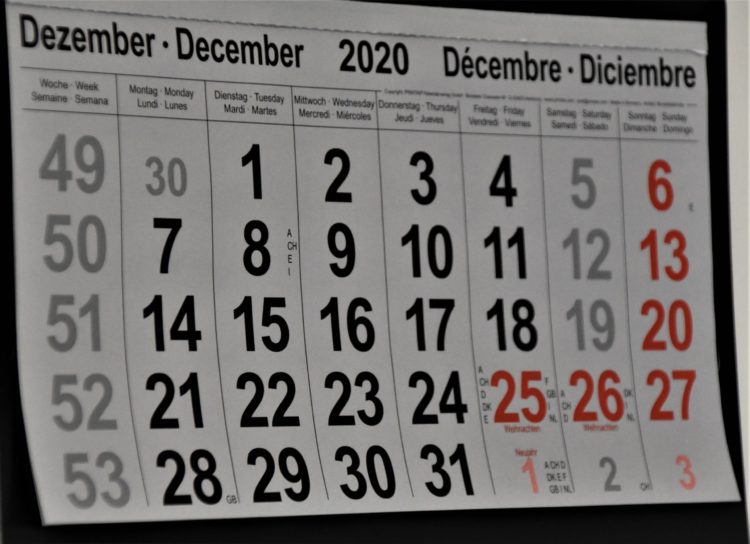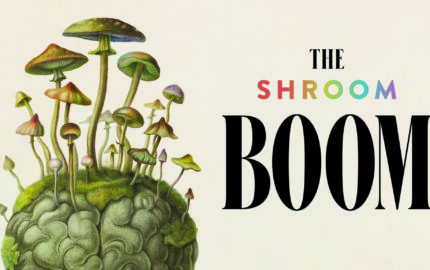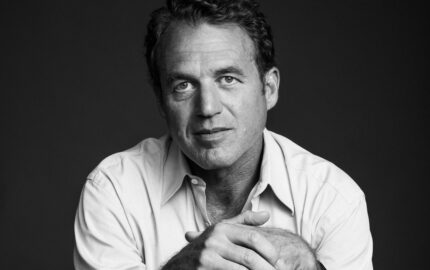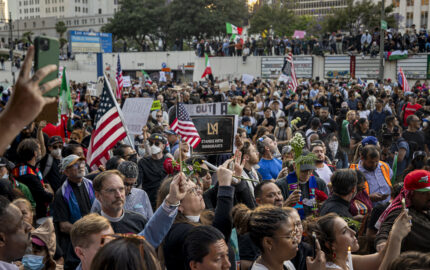A version of this essay was published as the Storyboard newsletter on Jan. 1, 2020
A flip of a calendar page and, just like that, 2020 is over. Of course, it wasn't just like that. It wasn't like anything anyone alive has ever known. And while the calendar year is behind us, its mash-up of challenges remains ahead — perhaps for months or more. The world is tired and more than a little bit anxious.
Journalists are not immune. We are somewhere in the mix of frontline and essential workers who can't just step aside and let this chaos play itself out while we scroll through Netflix.
By many measures, it's been a terrible year for journalists. Fifty were killed worldwide because of their work, according to Reporters Without Borders; more than two-thirds of those deaths took place in countries that are considered "at peace." The Committee to Protect Journalists puts the count at 30 — still far too many. Confronting corruption has become as dangerous as covering a war zone. Just after the New Year, the Poynter Institute reported a count of more than 500 journalists who who have died of COVID. News deserts expanded, too, as more newsrooms — especially those in small markets where they, alone, tracked local issues — were shuttered. About 1,800 U.S.-based newspapers have closed since 2004, and the pace of closures, which has averaged about 100 per year, picked up in the COVID economy; at those that survive, layoffs, furloughs, wage cuts and reduced publication days have become standard. Magazines struggled, too; the sudden end of California Sunday silenced one of the richest journalistic voices on the West Coast. Even powerhouses like ESPN felt the pinch.
Amid all that, news moved with blistering speed, requiring more and better from journalists as the grueling year wore on. The pandemic, political strife, the rise of nationalism, economic fissures, environmental crises, racial reckoning — those claimed the big headlines but were just the tip of a vast iceberg of issues in dire need of attention. For me, it came together in a single Facebook post this week from Therese Bottomly, the editor of The Oregonian, when she referred to 2020 as "the year we bought bulletproof vests for our staff."
So yes, a terrible year. But also a thrilling one.
Seldom has the mission of journalism been more clear or the work more crucial. There is no time or tolerance for fluffy assignments. Nerdy topics like epidemiology and virology are hot. Every day presents a crash course in law and civics. Even lifestyle stories, about things like cooking and crafts, have taken on notes of necessity. Entertainment is framed in terms of economic and mental health. Technology is no longer about the shiniest new toys, but the gears of survival. The intangible processes of education have come home to roost — revealing the ugly societal inequities that underlie the catch-all "achievement gap."
For the foreseeable future, COVID and politics will own the spotlight. One of the creative imperatives facing journalists will be to keep sharp on those fronts, but also to look beyond. We need to find ways to get environmental stories back on Page One. The volume needs to be turned back up on the Black Lives Matter movement and the insidious reality of racial injustice. In the U.S., we need to shake off an inevitable myopia and expand attention to international news. We need to be clear about the difference between the economy and the markets. And we need to ramp up the battle against the rise of misinformation and faux news sites. No less than the survival of democracy depends on it.
It's a lot to ask. And journalists, with the rest of the world, are tired and anxious.
But when I review the work that's been done the past year, I recognize a core trait of this profession: The more demanding the story, the better the work behind it. This storied year gave rise to amazing stories.
End-of-year summaries are usually best-of lists. I couldn't begin to pick from the range of stories and projects we featured on Storyboard this past year. (True to the times, at least 30 were somehow related to COVID coverage.) For every story we highlighted, there were at least 10 more we couldn't get to. For all the harshness of the news itself, the elegance of coverage just rose and rose. Most days had me reaching for my dictionary to learn a new word, or nodding with appreciation at a brilliant metaphor, a gorgeous turn of phrase or a taut storyline that pulled me through the thorniest information.
I also noticed something that may be of special interest in the Storyboard world: While investigative and explanatory journalism are the imperatives in these times, narrative is no longer something exotic or discretionary. The reporters who took me into a COVID ward or a White House blow-up or a street riot or a tax filing did it as masterful storytellers. Isolation and distance may have been the rules of the year, but these stories weren't phoned in.
I'm not a great student of history. But I found myself thinking of that famous line: "These are the times that try men's souls." I boosted my memory with a quick search: It comes from the opening lines of of Thomas Paine's pamphlets, published during in 1776 and aptly named "The American Crisis." I am willing to embarrass myself by admitting that I didn't know the rest of the reference:
The summer soldier and the sunshine patriot may, in this crisis, shrink from the service of his country; but he that stands it now, deserves the love and thanks of man and woman.
The journalism I've read and benefited from this past year has not been the work of summer soldiers. It is, rather, work that has earned every bit of my love and thanks.
A flip of a calendar page and, just like that, 2020 is over. Of course, it wasn't just like that. It wasn't like anything anyone alive has ever known. And while the calendar year is behind us, its mash-up of challenges remains ahead — perhaps for months or more. The world is tired and more than a little bit anxious.
Journalists are not immune. We are somewhere in the mix of frontline and essential workers who can't just step aside and let this chaos play itself out while we scroll through Netflix.
By many measures, it's been a terrible year for journalists. Fifty were killed worldwide because of their work, according to Reporters Without Borders; more than two-thirds of those deaths took place in countries that are considered "at peace." The Committee to Protect Journalists puts the count at 30 — still far too many. Confronting corruption has become as dangerous as covering a war zone. Just after the New Year, the Poynter Institute reported a count of more than 500 journalists who who have died of COVID. News deserts expanded, too, as more newsrooms — especially those in small markets where they, alone, tracked local issues — were shuttered. About 1,800 U.S.-based newspapers have closed since 2004, and the pace of closures, which has averaged about 100 per year, picked up in the COVID economy; at those that survive, layoffs, furloughs, wage cuts and reduced publication days have become standard. Magazines struggled, too; the sudden end of California Sunday silenced one of the richest journalistic voices on the West Coast. Even powerhouses like ESPN felt the pinch.
Amid all that, news moved with blistering speed, requiring more and better from journalists as the grueling year wore on. The pandemic, political strife, the rise of nationalism, economic fissures, environmental crises, racial reckoning — those claimed the big headlines but were just the tip of a vast iceberg of issues in dire need of attention. For me, it came together in a single Facebook post this week from Therese Bottomly, the editor of The Oregonian, when she referred to 2020 as "the year we bought bulletproof vests for our staff."
So yes, a terrible year. But also a thrilling one.
Seldom has the mission of journalism been more clear or the work more crucial. There is no time or tolerance for fluffy assignments. Nerdy topics like epidemiology and virology are hot. Every day presents a crash course in law and civics. Even lifestyle stories, about things like cooking and crafts, have taken on notes of necessity. Entertainment is framed in terms of economic and mental health. Technology is no longer about the shiniest new toys, but the gears of survival. The intangible processes of education have come home to roost — revealing the ugly societal inequities that underlie the catch-all "achievement gap."
For the foreseeable future, COVID and politics will own the spotlight. One of the creative imperatives facing journalists will be to keep sharp on those fronts, but also to look beyond. We need to find ways to get environmental stories back on Page One. The volume needs to be turned back up on the Black Lives Matter movement and the insidious reality of racial injustice. In the U.S., we need to shake off an inevitable myopia and expand attention to international news. We need to be clear about the difference between the economy and the markets. And we need to ramp up the battle against the rise of misinformation and faux news sites. No less than the survival of democracy depends on it.
It's a lot to ask. And journalists, with the rest of the world, are tired and anxious.
But when I review the work that's been done the past year, I recognize a core trait of this profession: The more demanding the story, the better the work behind it. This storied year gave rise to amazing stories.
End-of-year summaries are usually best-of lists. I couldn't begin to pick from the range of stories and projects we featured on Storyboard this past year. (True to the times, at least 30 were somehow related to COVID coverage.) For every story we highlighted, there were at least 10 more we couldn't get to. For all the harshness of the news itself, the elegance of coverage just rose and rose. Most days had me reaching for my dictionary to learn a new word, or nodding with appreciation at a brilliant metaphor, a gorgeous turn of phrase or a taut storyline that pulled me through the thorniest information.
I also noticed something that may be of special interest in the Storyboard world: While investigative and explanatory journalism are the imperatives in these times, narrative is no longer something exotic or discretionary. The reporters who took me into a COVID ward or a White House blow-up or a street riot or a tax filing did it as masterful storytellers. Isolation and distance may have been the rules of the year, but these stories weren't phoned in.
I'm not a great student of history. But I found myself thinking of that famous line: "These are the times that try men's souls." I boosted my memory with a quick search: It comes from the opening lines of of Thomas Paine's pamphlets, published during in 1776 and aptly named "The American Crisis." I am willing to embarrass myself by admitting that I didn't know the rest of the reference:
The summer soldier and the sunshine patriot may, in this crisis, shrink from the service of his country; but he that stands it now, deserves the love and thanks of man and woman.
The journalism I've read and benefited from this past year has not been the work of summer soldiers. It is, rather, work that has earned every bit of my love and thanks.



